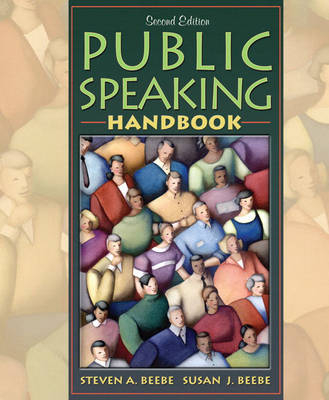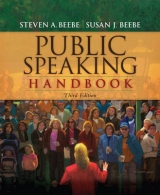
Public Speaking Handbook
Pearson (Verlag)
978-0-205-50296-7 (ISBN)
- Titel erscheint in neuer Auflage
- Artikel merken
Public Speaking Handbook brings theory and practice together in an understandable and applicable manner. Its distinctive and popular approach emphasizes the importance of analyzing and considering the audience at every point along the way. This model of public speaking serves as a foundation as the text guides the reader through the step-by-step process of public speaking, focusing their attention on the importance and dynamics of diverse audiences, and narrowing the gap between the learning environment and the real world.
Chapter 1 Introduction to Public Speaking
1.a Why Study Public Speaking?
Empowerment
Employment
1.b Public Speaking and Conversation
Public Speaking Is Planned
Public Speaking Is Formal
The Roles of Public Speakers and Audiences are Clearly Defined
1.c The Communication Process
Communication as Action
Communication as Interaction
Communication as Transaction
Quick Check: Understand the Communication Process
1.d The Rich Heritage of Public Speaking
Quick Check: The Rich Heritage of Public Speaking
1.e Public Speaking and Diversity
Diverse Audiences: A Coherent Framework
Diverse Audiences: A Unifying Principle
Chapter 2 Speaking with Confidence
2.a Understand Your Nervousness
What Makes People Nervous when Speaking in Public?
When are You Most Likely to Feel Nervous About Giving a Speech?
Does Your Style of Communication Apprehension Make a Difference?
You Are Going To Feel More Nervous Than You Look
Almost Every Speaker Experiences Some Degree of Nervousness
Anxiety Can Be Useful
2.b Build Your Confidence
Don’t Procrastinate in Preparing Your Speech
Know Your Audience
Select an Appropriate Topic
Be Prepared
Develop and Deliver a Well-Organized Speech
Know Your Introduction and Your Conclusion
Re-Create the Speech Environment When You Practice
Use Deep-Breathing Techniques
Channel Your Nervous Energy
How to Channel Your Nervous Energy
Visualize Your Success
Give Yourself a Mental Pep Talk
Focus on Your Message Rather Than Your Fear
Look for Positive Listener Support for Your Message
Seek Speaking Opportunities
After Your Speech, Focus on Your Accomplishment, Not Your Anxiety
Quick Check: Build Your Confidence
Chapter 3 The Audience-Centered Speechmaking Process
3.a An Audience-Centered Speechmaking Model
3.b Consider Your Audience
3.c Select and Narrow Your Topic
Who Is the Audience?
What Is the Occasion?
What Are My Interests, Talents, and Experiences?
3.d Determine Your Purpose
3.e Develop Your Central Idea
3.f Generate the Main Ideas
Does the Central Idea Have Logical Divisions?
Can You Think of Several Reasons Why the Central Idea Is True?
Can You Support the Central Idea with a Series of Steps?
3.g Gather Verbal and Visual Supporting Material
Criteria for Choosing Verbal Supporting Material
3.h Organize Your Speech
Divide Your Speech
Outline Your Speech
Consider Presentation Aids
3.i Rehearse Your Speech
Rehearse Your Speech Aloud
Practice Making Eye Contact
Make Decisions about the Style of Your Speech
3.j Deliver Your Speech
How to Prepare for a Speech
Chapter 4 Ethics and Free Speech
4.a Ethics
4.b Free Speech
4.c Speaking Freely
In the Twentieth Century
In Recent History
Quick Check: History of Free Speech in the United States
4.d Speaking Ethically
Have a Clear, Responsible Goal
Use Sound Evidence and Reasoning
Be Sensitive To and Tolerant of Differences
Be Honest
Avoid Plagiarism
Quick Check: The Ethical Public Speaker
4.e Listening Ethically
Communicate Your Expectations and Feedback
Be Sensitive To and Tolerant of Differences
Listen Critically
Quick Check: The Ethical Listener
Chapter 5 Listening to Speeches
5.a Barriers to Effective Listening
Select
Attend
Understand
Remember
Information Overload
How to Prevent Information Overload
Personal Concerns
Outside Distractions
How to Minimize Distractions
Prejudice
How to Counteract Prejudice
Differences Between Speech Rate and Thought Rate
Receiver Apprehension
How to Overcome Receiver Apprehension
5.b Becoming a Better Listener
Adapt to the Speaker’s Delivery
Listen With Your Eyes as Well as Your Ears
Monitor Your Emotional Reaction to a Message
Avoid Jumping to Conclusions
Be a Selfish Listener
Listen for Major Ideas
Identify Your Listening Goal
Practice Listening
Understand Your Listening Style
Quick Check: Enhance Your Listening Skills
Become an Active Listener
5.c Improve Your Note-Taking Skills
Prepare
Determine Whether You Need to Take Notes
Decide on the Type of Notes You Need to Take
Make Your Notes Meaningful
5.d Listening and Critical Thinking
Separate Facts from Inferences
Evaluate the Quality of Evidence
Evaluate the Underlying Logic and Reasoning
5.e Analyzing and Evaluating Speeches
Understanding Criteria for Evaluating Speeches
Identifying and Analyzing Rhetorical Strategies
Giving Feedback to Others
Giving Feedback to Yourself
Chapter 6 Analyzing Your Audience
6.a Becoming an Audience-Centered Speaker
How to Become an Audience-Centered Speaker
6.b Gather Information about Your Audience
Gathering Information Informally
Gathering Information Formally
Analyze Information About Your Audience
Adapt To Your Audience
6.c Analyzing Your Audience Before You Speak
Demographic Audience Analysis
Quick Check: Describing Cultural Differences
How To Use Diverse Strategies
Quick Check: Adapting to Diverse Listeners
Psychological Audience Analysis
Quick Check: Adapting Your Message to Different Types of Audiences
Situational Audience Analysis
6.d Adapting to Your Audience as You Speak
Identifying Nonverbal Audience Cues
Responding To Nonverbal Cues
Quick Check: Analyzing and Adapting to Your Audience as You Speak
Strategies for Customizing Your Message to Your Audience
6.e Analyzing Your Audience after You Speak
Nonverbal Responses
Verbal Responses
Survey Responses
Behavioral Responses
Chapter 7 Developing Your Speech
7.a Select and Narrow Your Topic
Guidelines For Selecting A Topic
Strategies for Selecting a Topic
How to Brainstorm for a Topic
Narrowing the Topic
7.b Determine Your Purpose
General Purpose
Specific Purpose
Quick Check: Specific Purposes for Speeches
7.c Develop Your Central Idea
A Complete Declarative Sentence
Direct, Specific Language
A Single Idea
An Audience-Centered Idea
Quick Check: Purpose Statement versus Central Idea
7.d Generate and Preview Your Main Ideas
Generating Your Main Ideas
Previewing Your Main Ideas
7.e Meanwhile, Back at the Computer . . .
Chapter 8 Gathering Supporting Material
8.a Personal Knowledge and Experience
8.b The Internet
The World Wide Web
Directories and Search Engines
How To Do an Advanced Search
Evaluating Web Resources
8.c Library Resources
Books
Periodicals
Full-Text Databases
Newspapers
Reference Resources
Government Documents
Special Services
Quick Check: Supporting Materials in the Resources
8.d Interviews
Determining the Purpose of the Interview
Setting Up the Interview
Planning the Interview
Conducting the Interview
Following Up the Interview
8.e Resources from Special-Interest Groups and Organizations
8.f Research Strategies
Develop a Preliminary Bibliography
How to Document an Electronic Resource in MLA Format
Evaluate the Usefulness of Resources
Take Notes
Identify Possible Presentation Aids
Quick Check: Research Strategies
Chapter 9 Supporting Your Speech
9.a Illustrations
Brief Illustrations
Extended Illustrations
Hypothetical Illustrations
Using Illustrations Effectively
Quick Check: Choose the Right Illustrations
9.b Descriptions and Explanations
Describing
Explaining How
Explaining Why
Using Descriptions and Explanations Effectively
9.c Definitions
Definitions By Classification
Operational Definitions
Using Definitions Effectively
Throughout a Speech
9.d Analogies
Literal Analogies
Figurative Analogies
Using Analogies Effectively
9.e Statistics
Using Statistics as Support
Using Statistics Effectively
Quick Check: Select Effective Statistics
9.f Opinions
Expert Testimony
Lay Testimony
Literary Quotations
Using Opinions Effectively
Quick Check: Types of Supporting Material
9.g Selecting the Best Supporting Material
How to Decide the Best Supporting Material
Chapter 10 Organizing Your Speech
10.a Organizing Your Main Ideas
Ordering Ideas Chronologically
Organizing Ideas Topically
Arranging Ideas Spatially
Organizing Ideas To Show Cause And Effect
Organizing Ideas By Problem And Solution
Acknowledging Cultural Differences in Organization
Quick Check: Organize Main Ideas
10.b Subdividing Your Main Ideas
10.c Integrating Your Supporting Material
Word-Processing Files
Note Cards
Photocopies
Smooth Incorporation of Support Material
Quick Check: Integrate Supporting Material
10.d Organizing Your Supporting Material
Primacy Or Recency
Specificity
Complexity
Soft To Hard Evidence
Quick Check: Organizing Your Supporting Material
10.e Developing Signposts
Transitions
Quick Check: Verbal Transitions
Previews
Summaries
Quick Check: Types of Signposts
10.f Supplementing Signposts with Presentation Aids
Chapter 11 Introducing Your Speech
11.a Purposes of Introductions
Get the Audience’s Attention
Introduce the Subject
Give the Audience a Reason to Listen
Establish Your Credibility
Preview Your Main Ideas
Quick Check: Purposes of Your Introduction
Quick Check: Does Your Introduction Accomplish Its Purpose?
11.b Effective Introductions
Illustrations or Anecdotes
Startling Facts or Statistics
Quotations
Humor
Questions
References to Historical Events
References to Recent Events
Personal References
References to the Occasion
References to Preceding Speeches
How to Develop an Effective Introduction
Chapter 12 Concluding Your Speech
12.a Purposes of Conclusions
Summarize the Speech
Reemphasize the Central Idea in a Memorable Way
Motivate the Audience to Respond
Provide Closure
Quick Check: Purposes of Your Speech Conclusion
12.b Effective Conclusions
References to the Introduction
Inspirational Appeals or Challenges
Appeals to Action
How to Develop an Effective Conclusion
Chapter 13 Outlining and Editing Your Speech
13.a Developing a Preparation Outline
The Preparation Outline
Quick Check: Summary of Correct Outline Form
Sample Preparation Outline
13.b Editing Your Speech
Review Your Specific Purpose
Consider Your Audience
Simply Say It
How to Avoid Long Phrases
Keep Only the Best Supporting Material
Ask a Listener to Help You Cut
Look at Your Introduction and Conclusion
13.c Developing Your Delivery Outline and Speaking Notes
The Delivery Outline
Sample Delivery Outline
Speaking Notes
Chapter 14 Using Words Well: Speaker Language and Style
14.a Oral versus Written Language Style
Oral Style Is More Personal Than Written Style
Oral Style Is Less Formal Than Written Style
Oral Style Is More Repetitive Than Written Style
Quick Check: Oral versus Written Style
14.b Using Words Effectively
Use Specific, Concrete Words
Use Simple Words
Use Words Correctly
14.c Adapting Your Language Style to Diverse Listeners
Use Language That Your Audience Can Understand
Use Appropriate Language
Use Unbiased Language
14.d Crafting Memorable Word Structures
Creating Figurative Images
Creating Drama
Creating Cadence
Quick Check: Crafting Memorable Word Structures
Analyzing an Example of Memorable Word Structure
14.e Tips For Using Language Effectively
How to Create Figurative Images, Drama, and Cadence
Chapter 15 Delivering Your Speech
15.a The Power of Speech Delivery
Listeners Expect Effective Delivery
Listeners Make Emotional Connections with You Through Delivery
Listeners Believe What They See
15.b Methods of Delivery
Manuscript Speaking
Memorized Speaking
Impromptu Speaking
Quick Check: Impromptu Presentations
Extemporaneous Speaking
Quick Check: Methods of Delivery
15.c Characteristics of Effective Delivery
Eye Contact
Quick Check: Benefits of Eye Contact
Gestures
Quick Check: Effective Gestures
Movement
Posture
Facial Expression
Vocal Delivery
Quick Check: Characteristics of Good Vocal Delivery
Personal Appearance
15.d Audience Diversity and Delivery
15.e Rehearsing Your Speech: Some Final Tips
How to Make the Most of Your Rehearsal Time
15.f Delivering Your Speech
15.g Adapting Your Speech Delivery for Television
Consider Toning Down Gestures
Dress for TV Success
Monitor Your Facial Expressions
Keep Your Target Audience In Mind
Keep It Short
Choose Your Words With Care And Style
Become Familiar with the Technology Before You Speak
15.h Responding to Questions
Chapter 16 Designing and Using Presentation Aids
16.a The Value of Presentation Aids
Presentation Aids Enhance Understanding
Presentation Aids Enhance Memory
Presentation Aids Help Listeners Organize Ideas
Presentation Aids Help Gain and Maintain Attention
Presentation Aids Help Illustrate a Sequence of Events or Procedures
Quick Check: The Value of Presentation Aids
16.b Types of Presentation Aids
Three-Dimensional Presentation Aids
Two-Dimensional Presentation Aids
How to Use an Overhead Projector
Audiovisual Aids
16.c Guidelines for Developing Presentation Aids
Allow Plenty of Time to Prepare Your Presentation Aids
Make Them Easy To See
Keep Them Simple
Group Related Elements into Visual Units
Establish A Consistent Graphic Theme
Choose A Typeface with Care
Vary Fonts and Font Sizes With Care
Use Color to Create a Mood and Sustain Attention
Use Black And White Effectively
Don’t Detract from the Message
Show Numerical Data Graphically
How to Select the Right Presentation Aids
16.d Guidelines for Using Presentation Aids
Do Not Use Dangerous or Illegal Presentation Aids
Rehearse with Your Presentation Aids
Make Eye Contact with Your Audience, Not with Your Presentation Aids
Explain Your Presentation Aids
Do Not Pass Objects Among Members of Your Audience
Use Animals with Caution
Use Handouts Effectively
Time the Use of Visuals to Control Your Audience’s Attention
Use Technology Effectively
Remember Murphy’s Law
How to Use Presentation Aids Effectively
Chapter 17 Using Presentation Software
17.a Presentation Software
17.b Using Presentation Software
Keep Sights and Sounds Simple
Repeat Visual Elements to Unify Your Presentation
Choose a Typeface With Care
Make Informed Decisions About Using Color
Allow Plenty of Time To Prepare Your Presentation Aids
How to Develop Effective PowerPoint Visuals
17.c Preparing A Presentation With PowerPoint
AutoContent Wizard
Template
Blank Presentation
Open an Existing Presentation
Saving a Presentation
Viewing a Presentation
Creating a Consistent Look
Creating A Distinctive Look
Printing a Presentation
Creating Speaker Notes and Handouts
Using Special Effects
Quick Check: Be Prepared
Chapter 18 Speaking to Inform
18.a Goals of Informative Speaking
Speaking To Enhance Understanding
Speaking To Maintain Interest
Speaking To Be Remembered
Quick Check: Goals of Informative Speeches
18.b Types of Informative Speeches
Speeches About Objects
Speeches About Procedures
Speeches About People
Speeches About Events
Speeches About Ideas
Quick Check: Types of Informative Speeches
18.c Strategies to Enhance Audience Understanding
Speak With Clarity
How to Enhance Message Clarity
Use Principles and Techniques Of Adult Learning
Clarify Complex Processes
Use Effective Visual Reinforcement
How to Enhance Audience Understanding
18.d Strategies to Maintain Audience Interest
Establish a Motive for Your Audience to Listen to You
Tell a Story
Quick Check: What Makes a Good Story?
Present Information That Relates to Your Listeners
18.e Strategies to Enhance Audience Recall
Build in Redundancy
Pace Your Information Flow
Reinforce Key Ideas Verbally
Reinforce Key Ideas Nonverbally
Quick Check: Enhance Audience Recall
Chapter 19 Understanding Principles of Persuasive Speaking
19.a Persuasion Defined
Attitudes
Beliefs
Values
19.b How Persuasion Works
19.c How to Motivate Listeners
Use Dissonance
Use Listener Needs
Use Positive Motivation
Use Negative Motivation
Quick Check: Using Fear Appeals to Persuade
19.d How to Develop Your Persuasive Speech
Consider the Audience
Select and Narrow Your Persuasive Topic
Determine Your Persuasive Purpose
Develop Your Central Idea and Main Ideas
19.e Putting Persuasive Principles into Practice
Quick Check: What Makes a Good Story?
Quick Check: Persuasive Propositions: Developing Your Central Idea
Chapter 20 Using Persuasive Strategies
20.a Establishing Credibility
20.b Enhancing Your Credibility
Initial Credibility
Derived Credibility
Terminal Credibility
20.c Using Logic and Evidence to Persuade
Understanding Types of Reasoning
How to Judge the Validity of a Generalization
How to Test the Truth of an Argument
Quick Check: Comparing Inductive, Deductive, Causal Reasoning
Persuading the Diverse Audience
Supporting Your Reasoning With Evidence
Avoiding Faulty Reasoning: Ethical Issues
20.d Using Emotion to Persuade
Tips for Using Emotion to Persuade
Using Emotional Appeals: Ethical Issues
How to Use Emotion to Persuade
20.e Strategies for Adapting Ideas to People and People to Ideas
Persuading the Receptive Audience
Persuading the Neutral Audience
20.f Strategies for Organizing Persuasive Messages
Problem–Solution
Refutation
Cause and Effect
The Motivated Sequence
Quick Check: Organizational Patterns for Persuasive Messages
Chapter 21 Special-Occasion Speaking
21.a Public Speaking in the Workplace
Reports
Public-Relations Speeches
21.b Ceremonial Speaking
Introductions
Quick Check: Introduce a Speaker
Toasts
Award Presentations
Nominations
Acceptances
How to Give an Acceptance Speech
Keynote Addresses
Commencement Addresses
Commemorative Addresses And Tributes
Eulogies
How to Deliver a Eulogy
21.c After-Dinner Speaking: Using Humor Effectively
Humorous Stories
Humorous Verbal Strategies
Humorous Nonverbal Strategies
Quick Check: Strategies for Achieving Humor in After-Dinner Speeches
Appendices
A Speaking in Small Groups
B The Classical Tradition of Rhetoric
C Suggested Speech Topics
D Speeches for Analysis and Discussion
| Erscheint lt. Verlag | 7.11.2006 |
|---|---|
| Sprache | englisch |
| Maße | 191 x 232 mm |
| Gewicht | 930 g |
| Themenwelt | Sachbuch/Ratgeber ► Beruf / Finanzen / Recht / Wirtschaft ► Briefe / Präsentation / Rhetorik |
| ISBN-10 | 0-205-50296-2 / 0205502962 |
| ISBN-13 | 978-0-205-50296-7 / 9780205502967 |
| Zustand | Neuware |
| Haben Sie eine Frage zum Produkt? |
aus dem Bereich



